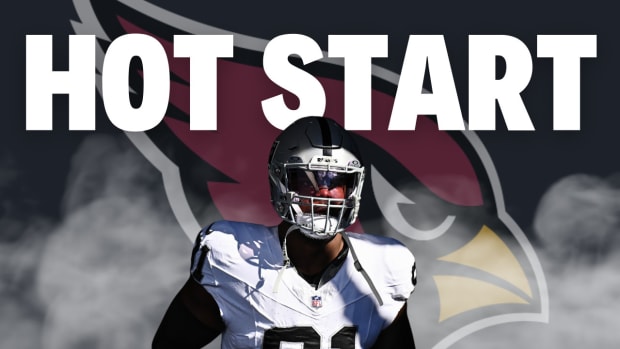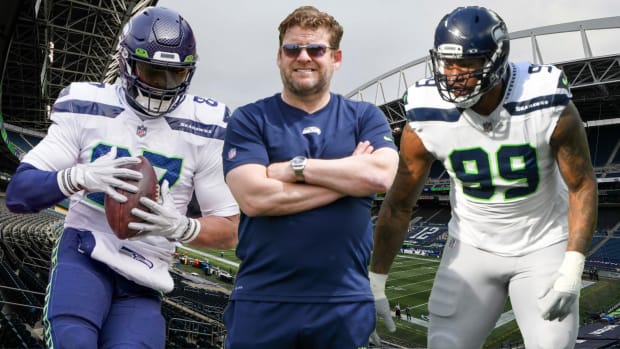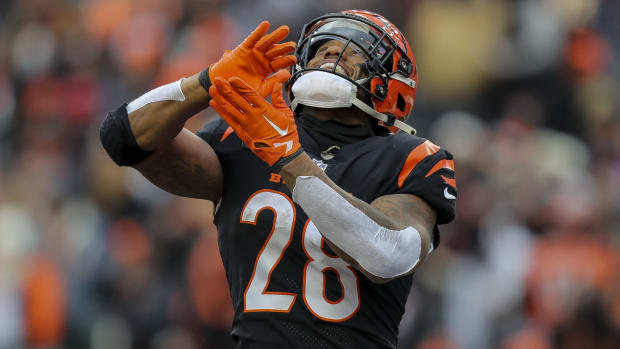The NFL’s Best and Worst Business Decisions
John Minchillo/AP
As a weekly columnist on NFL business, I never lack for issues, contracts, policies and player disputes that are interesting to debate and analyze. Looking back at 2014, which continued the recent trend of increasingly eventful and game-changing years in the business of football, here a few topics that stood out from the crowd.
Worst Player Contract
Tyron Smith, Cowboys
Smith’s extension binds him to the Cowboys for the extraordinary term of 10 years (effectively his entire career), with Smith taking all the risk after the first two years for which he was already under contract. Following a guaranteed $22 million over 2014-2015—a timeframe in which the offensive tackle had no reason to worry about guarantees—Smith remains signed for a staggering eight nonguaranteed years. This 10-year term is as onerous a length for a top player as I have seen. It appears the Cowboys leveraged Smith’s documented problems with family and money to their advantage.
At some point Smith will realize the harsh nature of his contract and request necessary upgrades in future guarantees. I have learned that a one-sided deal in pro football always comes back to haunt.
The contract also helps explain the lack of resolution with Dez Bryant and DeMarco Murray. Agents are not going to let the Cowboys use Smith’s deal as a precedent to impose similar structure.
Honorable mention
Colin Kaepernick, 49ers
Faced with the prospect of playing out his rookie contract for $900,000, Kaepernick jumped to $13 million this year. Everything beyond this $13 million in future years, however, is at the team’s discretion. Further, the deal contains team-friendly provisions rarely found in player contracts, let alone for quarterbacks, such as 1) having until April 1 each year—almost a month after the start of the free agency and trading—to decide whether to continue the contract; 2) a requirement that Kaepernick purchase a disability insurance policy with the team as the beneficiary; and 3) de-escalators reducing future salaries based on subpar performance. As with Smith, it appeared outside circumstances were in play. Kaepernick stayed loyal to a young agent while the sharks were circling, and it appears the 49ers leveraged that.
Best player contract
Jay Cutler, Bears
At this time last year, I thought the Bears would use the franchise tag to pay Cutler approximately $16 million while evaluating his body of work for another year before investing significant guarantees. Of course, they chose to forego that route and signed Cutler to a contract totaling $126 million (pay little attention to that number), with $54 million in guarantees. Now the Bears are locked into giving a player who appears to have regressed $15.5 million guaranteed next year—and a $10 million guarantee for 2016 that activates on March 12. Many have begun discussing an exit strategy from Cutler, though I believe he will remain a Bear. For what it’s worth, the Bears structured Cutler’s contract with no prorated signing bonus to protect against future salary cap charges if things continue to go south with him.
Honorable Mention
J.J. Watt, Texans
Early in the offseason, the Texans appeared to be leveraging Watt’s scheduled 2014-2015 compensation of $8.8 million, a truly inequitable sum for someone of his caliber. Owner Bob McNair even hinted at that plan in public comments before the team rewarded Watt on Labor Day. Watt became the NFL’s highest paid defensive player ever, locking in $31 million at the moment of his signing. He’s also set to trigger $51 million in guarantees—eclipsing Mario Williams’s $50 million—by March of 2016. And Watt, of course, projects as the NFL player least likely to coast after receiving top wages.
Alex Smith, Chiefs
Having made over $65 million in his career, Smith was able to be patient rather than jump at deals structured like Kapernick’s and Andy Dalton’s. He received an $18 million signing bonus, with a total of $31 million guaranteed at signing, and another $14-million guarantee will be triggered in March. Although the overall numbers resemble those of Kaepernick and Dalton, the structure allocates risk to the team rather than the player. Whatever the merits of Smith as a quarterback, he has succeeded in a tougher game than the one on the field: the business of football.
Best and Worst Team Values
The Best
2014 Year in Review
The 2014 MMQB awardsThe NFL season through the eyes of SI photographersHow all 32 teams finished compared to preseason predictionsAmid NFL turmoil, 2014 was a good year for the Bills
More valuable to teams than the rookie wage scale put in place by the new CBA is the prohibition of drafted rookies renegotiating their salaries (even if the team wants to) until after the player’s third contract year. This gives teams incredible value on players such as:
Russell Wilson, Seahawks
Now playing for $662,000, he is a runaway winner in this category and has been for a couple years. Absent the CBA restriction, this is a $20 million a year player.
Odell Beckham Jr., Giants
Although he’s a first-round draft pick making $10 million over four years, the fact that the Giants have him under contract at this level for at least two more years is an astonishing value. He has already proven to change the game; in an unrestricted market he’d making about $15 million annually, on par with players such as Calvin Johnson and Larry Fitzgerald.
DeMarco Murray, Cowboys
Not only have the Cowboys have had the league’s best running back this year, they had him playing in the last year of his rookie contract for $1.4 million. As written in this space, it remains unclear whether his immense production has helped or actually hurt his campaign for an elite contract.
The Worst
Jay Cutler, Bears
The Bears paid $22.5 million for a player that was benched in favor of Jimmy Clausen. Enough said.
Jadeveon Clowney, Texans
It’s hard to put a rookie in this category, but Clowney made more than $15 million of his four-year, $22 million contract in 2014 and the specter of microfracture surgery lingers. In my experience, when the team doctor is discussing microfracture surgery—an attempt to regenerate knee cartilage where there is none—there should be true concern about longevity for the player.
Adrian Peterson, Vikings & Greg Hardy, Panthers
These players were “negotiated” onto the commissioner’s exempt list in September. The deal appeased sponsors and a restless public by removing the radioactive players from the field, but the players maintained their substantial contracts. Thus, the Vikings and Panthers respectively paid Peterson and Hardy $691,000 and $771,000 per week through the majority of the season (Peterson moved to the suspended list after his appeal was denied). The only value for the teams was removing their toxicity to sponsors and fans.
The NFL’s Best Decision
Thursdays on CBS
In choosing between networks for the Thursday night package, the NFL was diabolically strategic in choosing the highest-rated entertainment programming for Thursday nights, CBS. The league simultaneously boosted its TNF ratings while expunging its biggest competitor. And with only a one-year commitment, they can now negotiate the next TNF package with a higher floor. For anyone who’s not been paying attention, these owners are not exactly benevolent negotiators.
The NFL’s Worst Decision
The Ray Rice discipline
No “worst” category involving the NFL in 2014 is complete without mentioning the Rice matter. To me, it appeared the NFL wanted to do a “favor” for 1) Rice, a model citizen and player prior to this transgression, and 2) the Ravens, who invested a tremendous amount of political capital on Rice’s behalf. The downward spiral from the elevator video being released illustrated the reactive nature of the league’s missteps. Former FBI Director Robert Mueller will judge the league and there could be some form of public censure for Roger Goodell and/or others, discipline that would ironically based on the same principles of the commissioner’s personal conduct policy.
NFLPA’s Best Decision
The Ray Rice appeal
Armed with the leverage of Goodell as witness rather than judge and jury, the union pushed for and achieved a truly independent appeal for Rice. Judge Barbara Jones strongly rebuked Goodell and his associates, using phrases like “arbitrary” and “abuse of discretion” in condemning the NFL. Unfortunately for the union, this desired model for player conduct appeals appears to be a one-and-done as...
NFLPA’s Worst Decision
Allowing the commissioner to have power over appeals
This decision was actually made in 2011, but the amount of energy, resources and lawyer fees unsuccessfully spent in 2014 to reverse it have been staggering. The union had made it a priority in 2011 to rein in Goodell on player conduct powers, but other issues such as player safety measures—an easy “give” for the owners—took priority and the commissioner refused to surrender authority of personal conduct appeals. The new conduct policy now looks very similar to the old conduct policy, granting Roger Goodell (or his designee) appeal powers over player conduct. Judge Jones may end up being an asterisk in the ongoing saga of the Conduct Commissioner.
What will 2015 bring? Certainly a whole new set of issues and problems off the field. And look for measures to address the in-game viewing experience compared to home viewing, the continued wrangling over a Los Angeles franchise, and more league accountability issues. We long ago passed the Rubicon on this: the business of the NFL is the NFL.
Follow The MMQB on Facebook, Twitter and Instagram.
[widget widget_name="SI Newsletter Widget”]











































